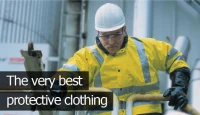What is it?
Developed in the 1950s, Proban is a flame retardant chemical treatment that is applied in bulk to woven and knitted cotton or cotton blend fabrics at the finishing stage. Proban can be used not only for industrial, sport and military workwear but across many civilian industries including hotels, public buildings, hospitals, nursing homes – anywhere fires are a risk.
To ensure high quality, the Proban process is only used by textile finishers specifically licensed by Rhodia, the company who produces Proban. The treatment renders the fabrics flame retardant to industry fire regulation levels. Flame Retardant means that the fabric will self-extinguish upon removal from a flame source (see video below.) Proban treated fabrics still char and burn but unlike untreated cotton they will not continue to burn or smoulder after they are removed from an ignition source nor will they melt or stick like polyester.
This means Proban treated garments are best suited to situations where personnel are at risk of being exposed to fire for a short duration and where the garments will be worn for an extended period of time. For example Proban is ideal for use on wildland firefighting garments and on workware in the oil, chemical, gas, electric and petrochemical industries. However, clothing made from Proban treated fabrics should not be worn in environments where they could be exposed to acids, strong reducing agents and/or oxidizing chemicals.
Each batch of Proban treated fabrics are independently tested to meet fire safety standards and to ensure that they retain their flame retardant properties for a minimum of 50 washes at 75C.
How does it work?
The Proban treatment process involves several specific steps and is only available to carefully selected licensees. Proban itself is a low molecular weight, polymeric chemical that is impregnated into the fabric. The fabric is then dried to a specific moisture content before being cured by exposure to high-concentration ammonia gas. Next it is oxidized with hydrogen peroxide, washed, dried again and finally softened with a polyethylene textile softener.
Flame-retardancy is achieved by the formation of a cross-linked inert polymer within the fibre. Because the polymer is inert, it leaves the base fabric unaffected and because it is insoluble it cannot be washed out (except by incorrect laundering.) When exposed to heat, the flame retardant breaks down to form an acid in the fabric which masks the cellulose of the cotton and catalyses char formation. The carbon is then coated by potassium preventing oxidation. Essentially when Proban treated fabric is exposed to flame it forms a localised char that acts as an insulating layer.
Proban provides a comfortable, reliable and cost effective solution to fire safety in the workplace.




Pingback: Pyrovatex: Flame Retardant Fabric Focus Part 4 | specialistworkclothing